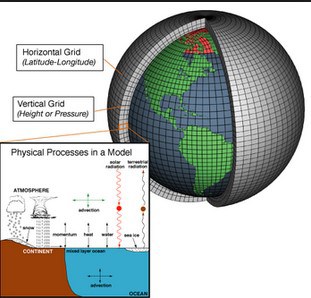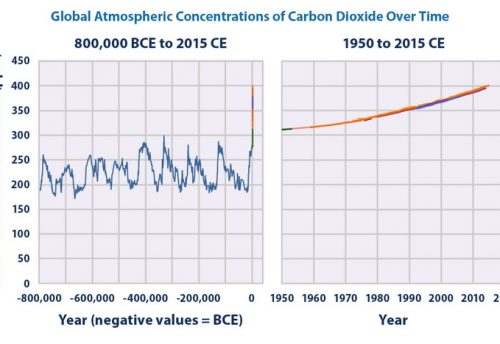
The importance of considering different time scales when investigating climate change has already been identified. Climate varies on all time scales (Mitchell, 1976), in response to random and periodic forcing factors. Across all time periods from a few years to hundreds of millions of years there is a white (background) noise of random variations of the climate, caused by internal processes and associated feedback mechanisms, often referred to as stochastic or random mechanisms (Goodess et al, 1992). Such randomness accounts for much of the climate variation, and owes its existence to the complex and chaotic behaviour of the climate system in responding to forcing (Lorenz, 1991; Nicolis & Nicolis, 1984; Palmer, 1989). An essential corollary of the existence of random processes is that a large proportion of climate variation cannot be predicted.
Of far more relevance are the periodic forcing factors, for by understanding their mechanisms and the impacts they have on the global climate, it is possible to predict future climate change. How the climate system responds to periodic forcing factors, however, is often not clear. If it is assumed that the climate system responds in a linear fashion to periodic forcing, variations in climate will exhibit similar periodicity. If, however, the response of the system to forcing is strongly non-linear, the periodicities in the response will not necessarily be identical to the periodicities in the forcing factor(s). Frequently, the climate responds in a fashion intermediate between the two.
There are many climate forcing factors spanning an enormous range of periodicities. The longest, 200 to 500 million years, involves the passage of our Solar System through the galaxy, and the variations in galactic dust (Williams, 1975a). These may be considered to be external forcing mechanisms (section 2.5.1). Other long time scale variations (106 to 108 years) include the non-radiative forcing mechanisms, such as continental drift, orogeny (mountain building) and isostasy (vertical movements in the Earth’s crust affecting sea level) (Raymo & Ruddiman, 1992; Ruddiman & Kubasch, 1991). These are internal forcing mechanisms (sections 2.6.1 and 2.6.2). External changes in the amount of solar radiation (Wigley & Kelly, 1990; Eddy, 1976, 1977, 1982; section 2.5.3) and the Earth’s orbit around the Sun (Milankovitch, 1941; Berger, 1978, 1984; section 2.5.2), and internal variations in volcanic activity (Sear et al., 1987; section 2.6.3), ocean circulation (Broecker & Denton, 1990; section 2.6.4) and atmospheric composition (IPCC, 1990a, 1992, 1995; section 2.6.5), all occur over time scales from 1 year to 105 years. Additionally, there are numerous other internal feedback mechanisms (see section 2.7) which all contribute to the changing of the global climate. The actual climate state at any point in time represents an aggregate response to all cycles of variation superimposed on the background noise.
The response of the climate system to this combination of forcing factors itself depends upon the different response times of the various components of the system. The overall climatic response will then be determined by the interactions between the components. The atmosphere, surface snow and ice, and surface vegetation typically respond to climatic forcing over a period of hours to days. The surface ocean has a response time measured in years, whilst the deep ocean and mountain glaciers vary only over a period spanning hundreds of years (Henderson-Sellers & McGuffie, 1987). Large ice sheets advance and withdraw over thousands of years whilst parts of the geosphere (e.g. continental weathering of rocks) respond only to forcing periods lasting hundreds of thousands to millions of years.
The response of the climate system to episodes of forcing can be viewed as a form of resonance. When the time period of forcing matches most closely the response time of a particular system component, the climatic response will be greatest within that component. Milankovitch forcing (section 2.5.2), for example, with periods of tens of thousands of years will be manifest in the response of the ice sheets (section 5.3.1), and the overall response of the climate system will be dominated by changes within the cryosphere. In addition, longer response times of certain components of the climate system modulate, through feedback processes, the short term responses. The response of the deep ocean to short term forcing (e.g. enhanced greenhouse effect (section 2.6.5), solar variations (section 2.5.3)), for example, will tend to attenuate or smooth the response of the atmosphere.
Throughout the remainder of this chapter, it should be recognised that a range of time scales applies to climate forcing mechanisms, radiative and non-radiative, external and internal, and to the response of the different components of the climate system.




Leave a Reply